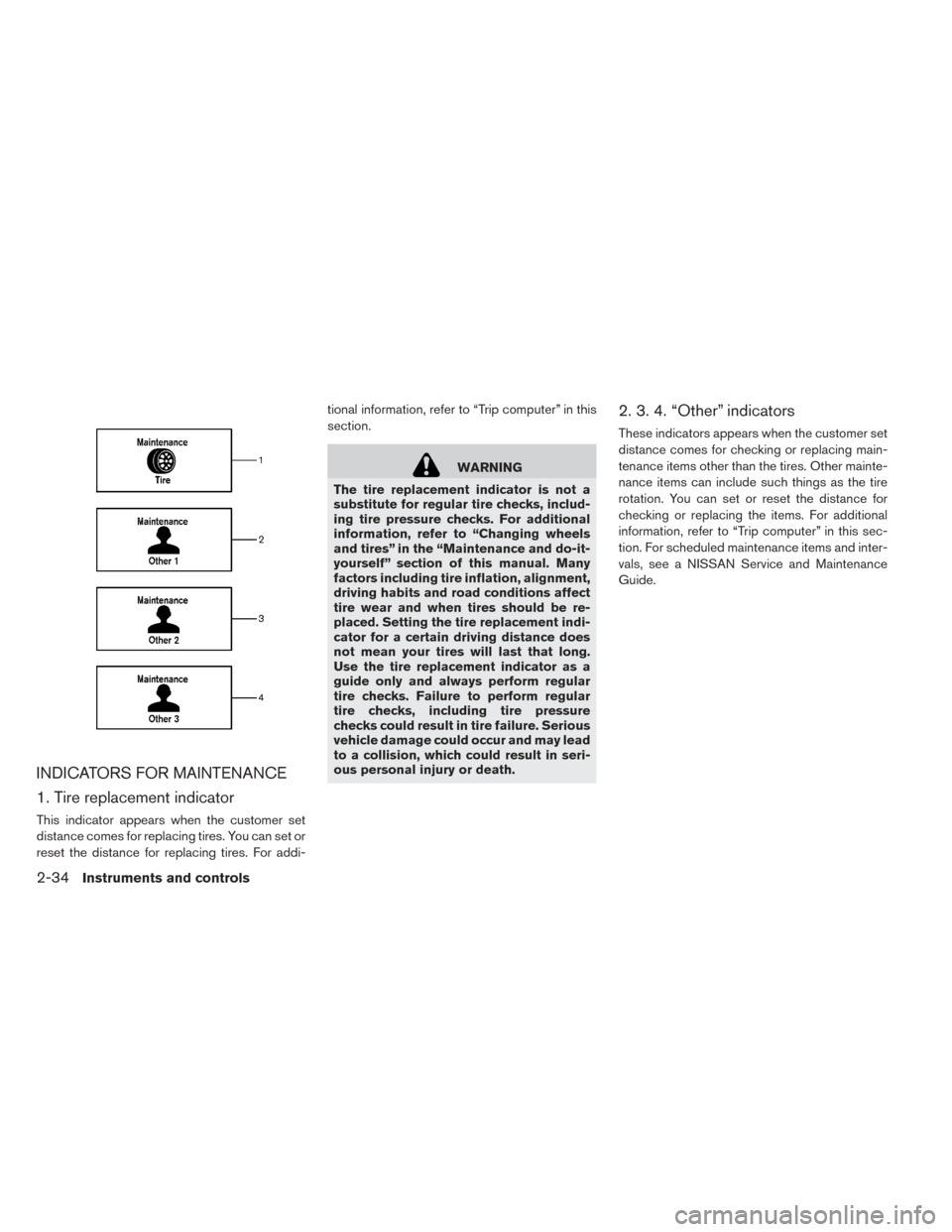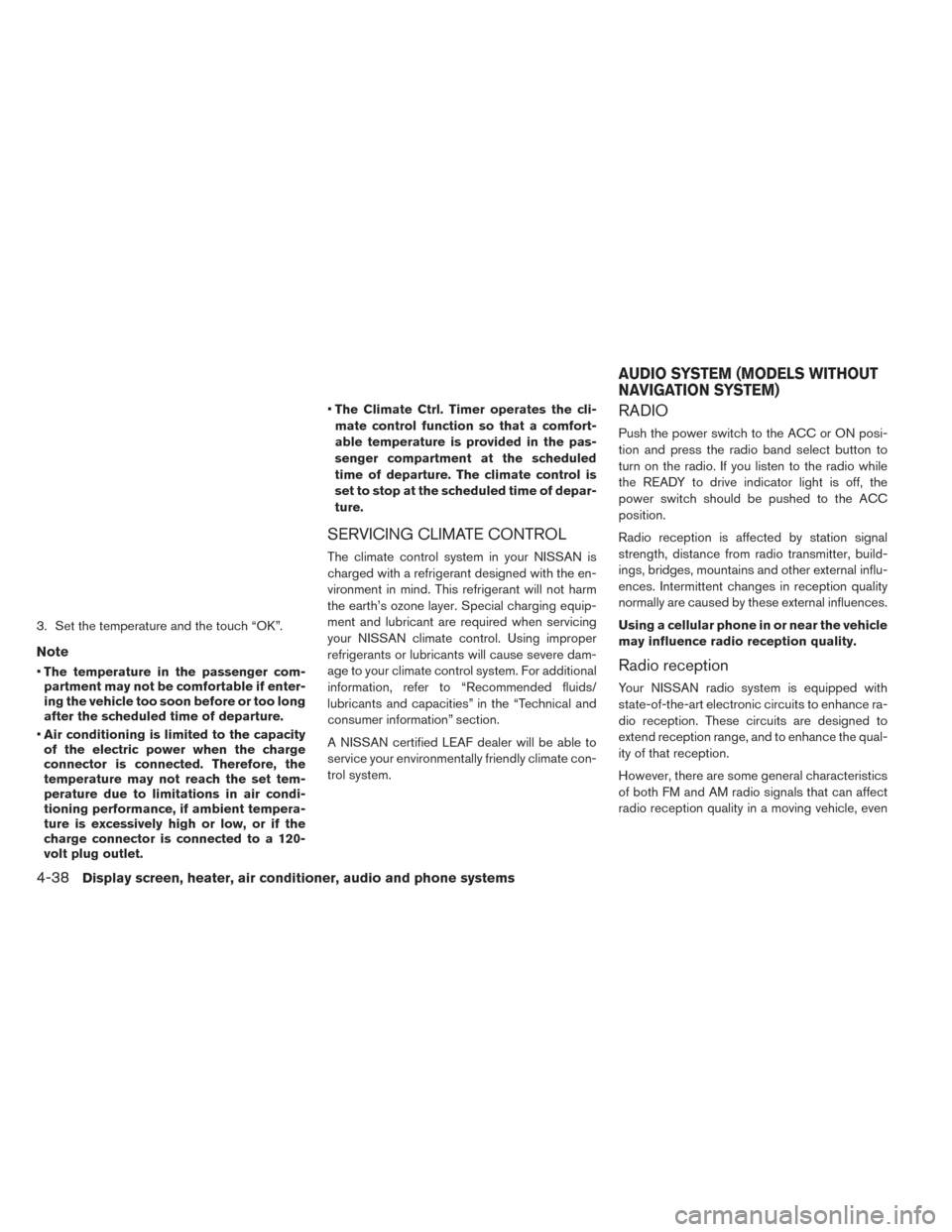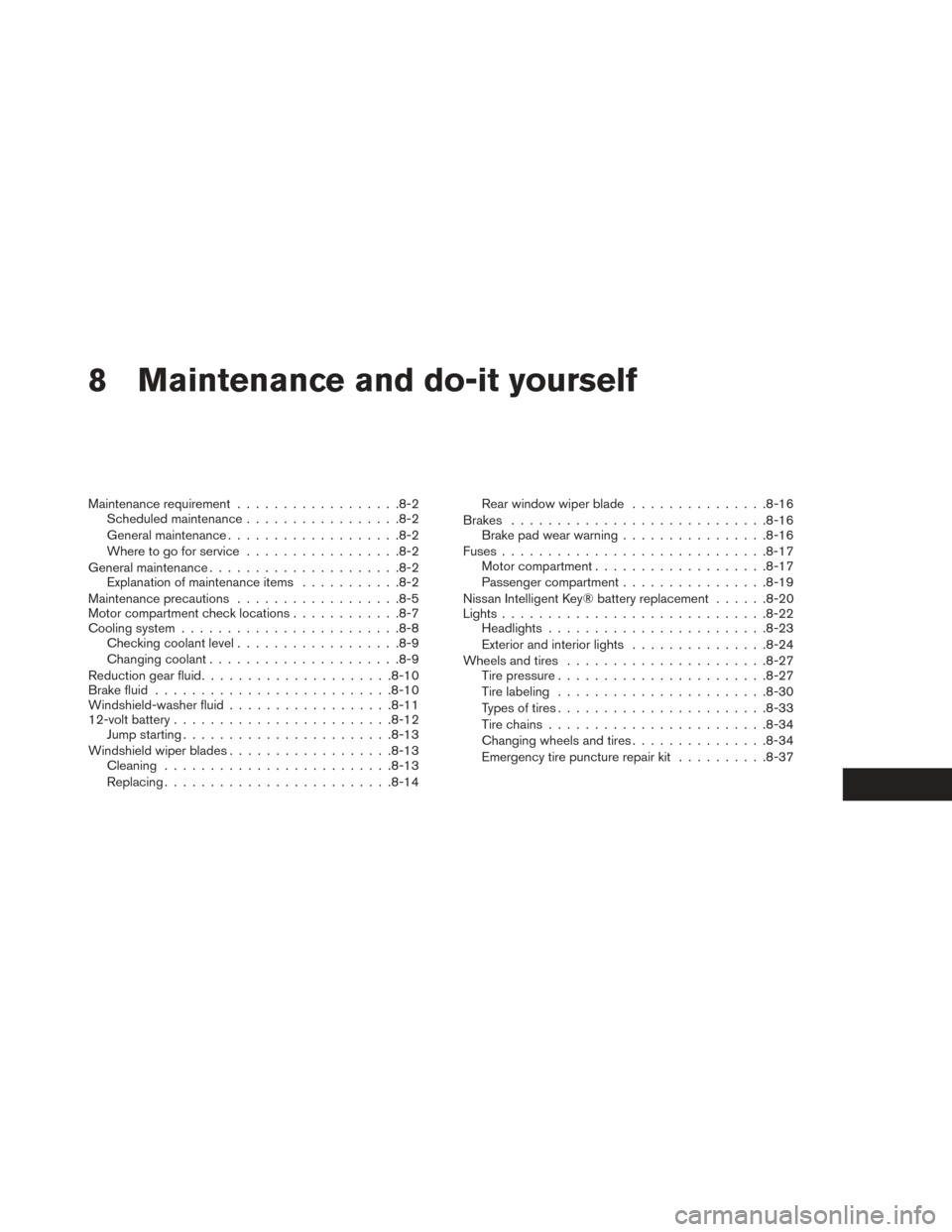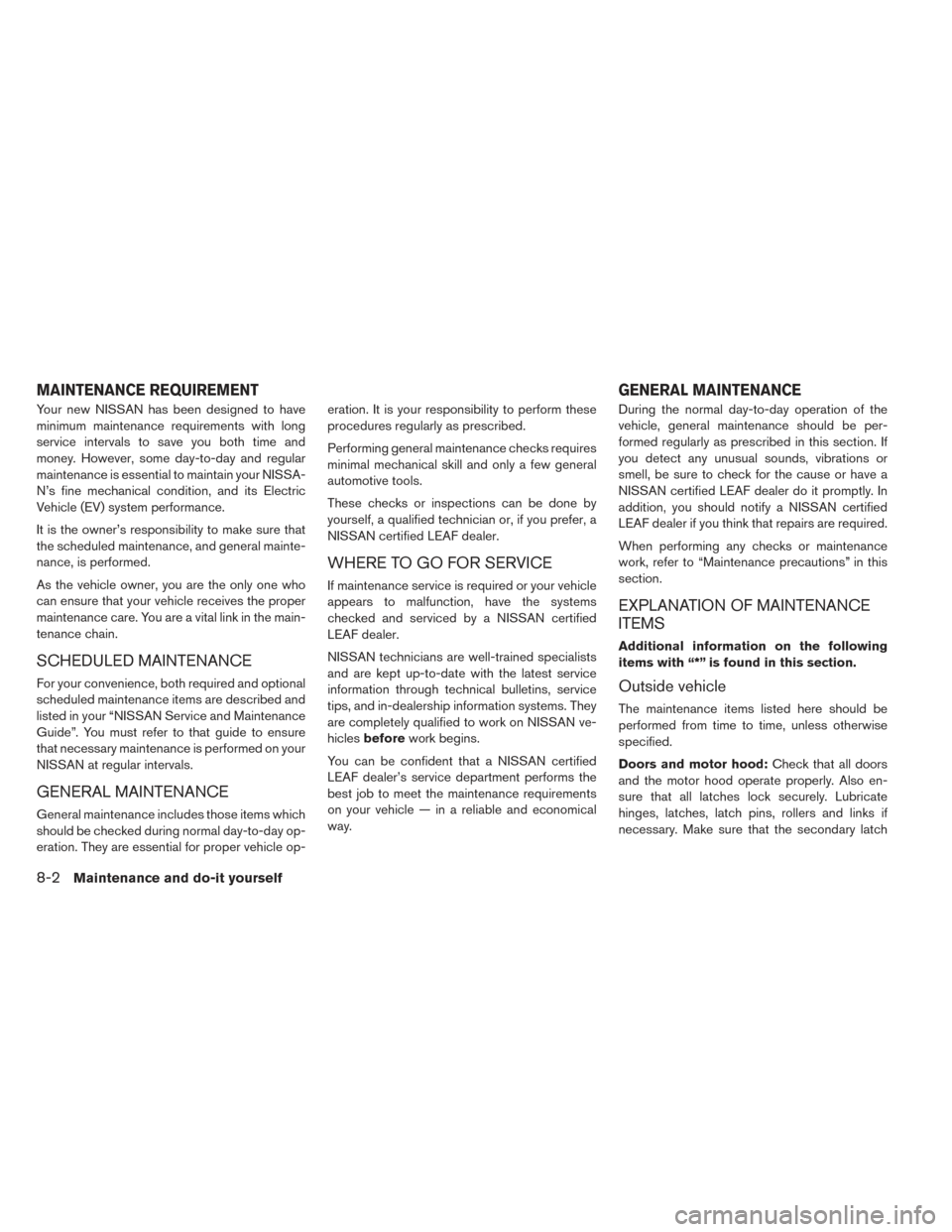2016 NISSAN LEAF service schedule
[x] Cancel search: service schedulePage 173 of 437

INDICATORS FOR MAINTENANCE
1. Tire replacement indicator
This indicator appears when the customer set
distance comes for replacing tires. You can set or
reset the distance for replacing tires. For addi-tional information, refer to “Trip computer” in this
section.
WARNING
The tire replacement indicator is not a
substitute for regular tire checks, includ-
ing tire pressure checks. For additional
information, refer to “Changing wheels
and tires” in the “Maintenance and do-it-
yourself” section of this manual. Many
factors including tire inflation, alignment,
driving habits and road conditions affect
tire wear and when tires should be re-
placed. Setting the tire replacement indi-
cator for a certain driving distance does
not mean your tires will last that long.
Use the tire replacement indicator as a
guide only and always perform regular
tire checks. Failure to perform regular
tire checks, including tire pressure
checks could result in tire failure. Serious
vehicle damage could occur and may lead
to a collision, which could result in seri-
ous personal injury or death.
2. 3. 4. “Other” indicators
These indicators appears when the customer set
distance comes for checking or replacing main-
tenance items other than the tires. Other mainte-
nance items can include such things as the tire
rotation. You can set or reset the distance for
checking or replacing the items. For additional
information, refer to “Trip computer” in this sec-
tion. For scheduled maintenance items and inter-
vals, see a NISSAN Service and Maintenance
Guide.
2-34Instruments and controls
Page 267 of 437

3. Set the temperature and the touch “OK”.
Note
•The temperature in the passenger com-
partment may not be comfortable if enter-
ing the vehicle too soon before or too long
after the scheduled time of departure.
• Air conditioning is limited to the capacity
of the electric power when the charge
connector is connected. Therefore, the
temperature may not reach the set tem-
perature due to limitations in air condi-
tioning performance, if ambient tempera-
ture is excessively high or low, or if the
charge connector is connected to a 120-
volt plug outlet. •
The Climate Ctrl. Timer operates the cli-
mate control function so that a comfort-
able temperature is provided in the pas-
senger compartment at the scheduled
time of departure. The climate control is
set to stop at the scheduled time of depar-
ture.
SERVICING CLIMATE CONTROL
The climate control system in your NISSAN is
charged with a refrigerant designed with the en-
vironment in mind. This refrigerant will not harm
the earth’s ozone layer. Special charging equip-
ment and lubricant are required when servicing
your NISSAN climate control. Using improper
refrigerants or lubricants will cause severe dam-
age to your climate control system. For additional
information, refer to “Recommended fluids/
lubricants and capacities” in the “Technical and
consumer information” section.
A NISSAN certified LEAF dealer will be able to
service your environmentally friendly climate con-
trol system.
RADIO
Push the power switch to the ACC or ON posi-
tion and press the radio band select button to
turn on the radio. If you listen to the radio while
the READY to drive indicator light is off, the
power switch should be pushed to the ACC
position.
Radio reception is affected by station signal
strength, distance from radio transmitter, build-
ings, bridges, mountains and other external influ-
ences. Intermittent changes in reception quality
normally are caused by these external influences.
Using a cellular phone in or near the vehicle
may influence radio reception quality.
Radio reception
Your NISSAN radio system is equipped with
state-of-the-art electronic circuits to enhance ra-
dio reception. These circuits are designed to
extend reception range, and to enhance the qual-
ity of that reception.
However, there are some general characteristics
of both FM and AM radio signals that can affect
radio reception quality in a moving vehicle, even
AUDIO SYSTEM (MODELS WITHOUT
NAVIGATION SYSTEM)
4-38Display screen, heater, air conditioner, audio and phone systems
Page 354 of 437

8 Maintenance and do-it yourself
Maintenance requirement................. .8-2
Scheduled maintenance ................ .8-2
General maintenance .................. .8-2
Where to go for service ................ .8-2
General maintenance .................... .8-2
Explanation of maintenance items ...........8-2
Maintenance precautions ................. .8-5
Motor compartment check locations ............8-7
Cooling system ....................... .8-8
Checking coolant level ................. .8-9
Changing coolant .................... .8-9
Reduction gear fluid .................... .8-10
Brake fluid ......................... .8-10
Windshield-washer fluid ................. .8-11
12-volt battery ....................... .8-12
Jump starting ...................... .8-13
Windshield wiper blades ................. .8-13
Cleaning ........................ .8-13
Replacing ........................ .8-14Rear window wiper blade
...............8-16
Brakes ........................... .8-16
Brake pad wear warning ................8-16
Fuses ............................ .8-17
Motor compartment .................. .8-17
Passenger compartment ................8-19
Nissan Intelligent Key® battery replacement ......8-20
Lights ............................ .8-22
Headlights ....................... .8-23
Exterior and interior lights ...............8-24
Wheels and tires ..................... .8-27
Tire pressure ...................... .8-27
Tire labeling ...................... .8-30
Types of tires ...................... .8-33
Tire chains .......................
.8-34
Changing
wheels and tires .............. .8-34
Emergency tire puncture repair kit ..........8-37
Page 355 of 437

Your new NISSAN has been designed to have
minimum maintenance requirements with long
service intervals to save you both time and
money. However, some day-to-day and regular
maintenance is essential to maintain your NISSA-
N’s fine mechanical condition, and its Electric
Vehicle (EV) system performance.
It is the owner’s responsibility to make sure that
the scheduled maintenance, and general mainte-
nance, is performed.
As the vehicle owner, you are the only one who
can ensure that your vehicle receives the proper
maintenance care. You are a vital link in the main-
tenance chain.
SCHEDULED MAINTENANCE
For your convenience, both required and optional
scheduled maintenance items are described and
listed in your “NISSAN Service and Maintenance
Guide”. You must refer to that guide to ensure
that necessary maintenance is performed on your
NISSAN at regular intervals.
GENERAL MAINTENANCE
General maintenance includes those items which
should be checked during normal day-to-day op-
eration. They are essential for proper vehicle op-eration. It is your responsibility to perform these
procedures regularly as prescribed.
Performing general maintenance checks requires
minimal mechanical skill and only a few general
automotive tools.
These checks or inspections can be done by
yourself, a qualified technician or, if you prefer, a
NISSAN certified LEAF dealer.
WHERE TO GO FOR SERVICE
If maintenance service is required or your vehicle
appears to malfunction, have the systems
checked and serviced by a NISSAN certified
LEAF dealer.
NISSAN technicians are well-trained specialists
and are kept up-to-date with the latest service
information through technical bulletins, service
tips, and in-dealership information systems. They
are completely qualified to work on NISSAN ve-
hicles
before work begins.
You can be confident that a NISSAN certified
LEAF dealer’s service department performs the
best job to meet the maintenance requirements
on your vehicle — in a reliable and economical
way. During the normal day-to-day operation of the
vehicle, general maintenance should be per-
formed regularly as prescribed in this section. If
you detect any unusual sounds, vibrations or
smell, be sure to check for the cause or have a
NISSAN certified LEAF dealer do it promptly. In
addition, you should notify a NISSAN certified
LEAF dealer if you think that repairs are required.
When performing any checks or maintenance
work, refer to “Maintenance precautions” in this
section.
EXPLANATION OF MAINTENANCE
ITEMS
Additional information on the following
items with “*” is found in this section.
Outside vehicle
The maintenance items listed here should be
performed from time to time, unless otherwise
specified.
Doors and motor hood:
Check that all doors
and the motor hood operate properly. Also en-
sure that all latches lock securely. Lubricate
hinges, latches, latch pins, rollers and links if
necessary. Make sure that the secondary latch
MAINTENANCE REQUIREMENT GENERAL MAINTENANCE
8-2Maintenance and do-it yourself